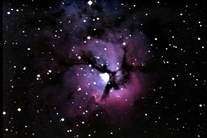m020avg4_ps2.c.jpg
m020avg4_ps2.c.jpg
(m020avg4_ps2.c.jpg)
M20 - Trifid Nebula
Image taken with 764mm (30") f/4.8 FPOA Challenger observatory scope.
The Trifid Nebula gets its name from the three main "petals" in this flower shaped nebula. There are actually four such petals, but only three were visible when it got its name, hense the "tri" part of its name. This nebula has lots of blue reflection nebula component to it, where as the nearby M8 Lagoon Nebula is different.
Messier 20
Starforming Nebula M20 (NGC 6514), an emission and reflection nebula, with Open Star Cluster, in Sagittarius
Trifid Nebula
Right Ascension 18 : 02.6 (h:m)
Declination -23 : 02 (deg:m)
Distance 5.2 (kly)
Visual Brightness 9.0 (mag)
Apparent Dimension 28.0 (arc min)
Discovered by Charles Messier in 1764.
Excerpt from seds.org:
The Trifid Nebula Messier 20 (M20, NGC 6514) in Sagittarius is a remarkable and beautiful object as it consists of both a conspicuous emission nebula and a remarkable reflection nebula component.
Charles Messier discovered this object on June 5, 1764, and described it as a cluster of stars of 8th to 9th magnitude, enveloped in nebulosity, where the remark on nebulosity follows only after the description of nearby M21, and includes that object.
The Trifid Nebula M20 is famous for its three-lobed appearance. This may have caused William Herschel, who normally carefully avoided to number Messier's objects in his catalog, to assign four different numbers to parts of this nebula: H IV.41 (cataloged May 26, 1786) and H V.10, H V.11, H V.12 (dated July 12, 1784). That he numbered this object at all may have its reason in the fact that Messier merely described it as 'Cluster of Stars.' The name 'Trifid' was first used by John Herschel to describe this nebula; this astronomer assigned only one catalog entry to the whole object (h 1991, h 3718, GC 4355) which became J.L.E. Dreyer's NGC 6514.
The dark nebula, which is the reason for the Trifid's appearance, was cataloged by Barnard as Barnard 85 (B 85).
The red emission nebula with its young star cluster near its center is surrounded by a blue reflection nebula which is particularly conspicuous to the northern end. The nebula's distance is rather uncertain, with values between 2,200 light years (Mallas/Kreimer; Glyn Jones has 2,300) and about 7,600 light years (C.R. O'Dell 1963). The Sky Catalog 2000 gives 5,200 light years, a value which is also used by Archinal and Hynes (2003), and which we adopt here. The WEBDA database has 3140, the Hubble Press Release of Jeff Hester (STScI-PRC99-42) gives "about 9000" light years.
As often for nebulae, magnitude estimates spread widely: Kenneth Glyn Jones gives 9.0, while Machholz has estimated 6.8 mag. This may partly come from the fact that the exciting star, HD 196692 or HN 40 or ADS 10991, is a triple system of 7th integrated magnitude (with components A: 7.6, B: 10.7, C: 8.7 mag). All are extremely hot; component A is of spectral type O5 to O7. The Sky Catalogue 2000.0 even lists 4 more, faint components of this "multiple star:" D: 10.7, E: 12.6, F: 14.0, and G: 13.4 mag. This star is located on the west side of the Trifid Nebula cluster. Situated on the northern edge is HD 164514 of visual magnitude 7.42, a supergiant of spectral type A5 Ia. The presence of these considerably bright stars makes brightness estimates for the nebula difficult.
In the sky, the Trifid nebula M20 is situated roughly 2 degrees northwest of the larger Lagoon Nebula M8, so that both nebulae form a nice target for wide field photographs, as these images of the M8 and M20 region, or the big DSSM image of this region. It is even closer to the open cluster M21 and shows up in the upper left edge of our M21 image.
